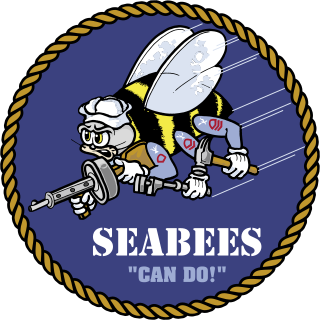
United States Naval Construction Battalions, better known as the Navy Seabees, form the U.S. Naval Construction Force (NCF). The Seabee nickname is a heterograph of the initial letters "CB" from the words "Construction Battalion". Depending upon context, "Seabee" can refer to all enlisted personnel in the USN's occupational field 13 (OF-13), all personnel in the Naval Construction Force (NCF), or Construction Battalion. Seabees serve both in and outside the NCF. During World War II they were plank-holders of both the Naval Combat Demolition Units and the Underwater Demolition Teams (UDTs). The men in the NCF considered these units to be "Seabee". In addition, Seabees served as elements of Cubs, Lions, Acorns and the United States Marine Corps. They also provided the manpower for the top secret CWS Flame Tank Group. Today the Seabees have many special task assignments starting with Camp David and the Naval Support Unit at the Department of State. Seabees serve under both Commanders of the Naval Surface Forces Atlantic/Pacific fleets as well as on many base Public Works and USN diving commands.

The United States Navy Sea, Air, and Land (SEAL) Teams, commonly known as Navy SEALs, are the U.S. Navy's primary special operations force and a component of the Naval Special Warfare Command. Among the SEALs' main functions are conducting small-unit special operation missions in maritime, jungle, urban, arctic, mountainous, and desert environments. SEALs are typically ordered to capture or to kill high level targets, or to gather intelligence behind enemy lines. SEAL team personnel are hand selected, highly trained, and possess a high degree of proficiency in direct action (DA), and special reconnaissance (SR), among other tasks like sabotage, demolition, intelligence gathering, and hydro-graphic reconnaissance, training, and advising friendly militaries or other forces.
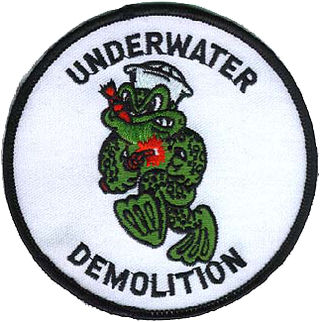
Underwater Demolition Teams (UDTs), or frogmen, were amphibious units created by the United States Navy during World War II with specialized non-tactical missions. They were predecessors of the navy's current SEAL teams.

The United States Armed Forces awards and decorations are primarily the medals, service ribbons, and specific badges which recognize military service and personal accomplishments while a member of the U.S. Armed Forces. Such awards are a means to outwardly display the highlights of a service member's career.

The United States Naval Special Warfare Command (USNSWC), also known as, is the naval component of United States Special Operations Command, the unified command responsible for overseeing and conducting the nation's special operations and missions.

The Special Warfare insignia, also known as the "SEAL Trident" or its popular nickname in the Navy community, "The Budweiser", recognizes those members of the United States Navy who have completed the Basic Underwater Demolition/SEAL (BUD/S) training, completed SEAL Qualification Training (SQT) and have been designated as U.S. Navy SEALs.

The Explosive Ordnance Disposal Badge is a military badge of the United States Armed Forces which recognizes those service members, qualified as explosive ordnance disposal (EOD) technicians, who are specially trained to deal with the construction, deployment, disarmament, and disposal of high explosive munitions including other types of ordnance such as nuclear, biological and chemical weapons along with improvised explosive devices (IED) and improvised nuclear devices (IND). Also known as the “EOD Badge” or "Crab", the decoration is issued by the United States Army, Air Force, Navy and Marine Corps. The EOD Badge is the only occupational badge awarded to all four services under the United States Department of Defense.

The diver insignia are qualification badges of the uniformed services of the United States which are awarded to servicemen qualified as divers. Originally, the diver insignia was a cloth patch decoration worn by United States Navy divers in the upper-portion of the enlisted service uniform's left sleeve during the first part of World War II, when the rating insignia was worn on the right sleeve. When enlisted rating insignia were shifted to the left sleeve in late World War II, the patch shifted to the upper right sleeve. The diving patch was created during World War II, and became a breast insignia in the late 1960s.
The Naval Flight Officer insignia is a breast insignia of the United States military which is awarded to those aviators of the Navy, Marine Corps and Coast Guard who have qualified as Naval Flight Officers (NFO) based on successful completion of flight training. The insignia is similar in design to the Naval Aviator insignia, consisting of a pair of golden wings, a shield, and crossed anchors.

The Parachutist Badge, also commonly referred to as "Jump Wings" is a military badge of the United States Armed Forces. The United States Space Force and United States Coast Guard are the only branches that do not award the Parachutist Badge, but their members are authorized to receive the Parachutist Badges of other services in accordance with their prescribed requirements. The DoD military services are all awarded the same Military Parachutist Badge. The U.S. Army and U.S. Air Force issue the same Senior and Master Parachutist Badges while the U.S. Navy and U.S. Marine Corps issue the Navy and Marine Corps Parachutist Badge to advanced parachutists. The majority of the services earn their Military Parachutist Badge through the U.S. Army Airborne School.

The Naval Special Warfare Command, commonly known as the Royal Thai Navy SEALs, is the special operations force of the Royal Thai Navy.

Insignias and badges of the United States Navy are military badges issued by the United States Department of the Navy to naval service members who achieve certain qualifications and accomplishments while serving on both active and reserve duty in the United States Navy. Most naval aviation insignia are also permitted for wear on uniforms of the United States Marine Corps.
The Aircrew Badge, commonly known as Wings, is a qualification badge of the United States military that is awarded by all five branches of armed services to personnel who serve as aircrew members on board military aircraft. The badge is intended to recognize the training and qualifications required by aircrew of military aircraft. In order to qualify as an aircrew member and receive the Aircrew Badge, such personnel typically undergo advanced training in aircraft in-flight support roles.
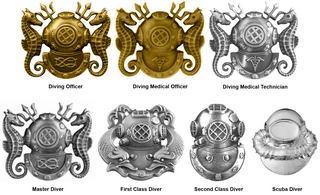
The United States Navy master diver is the highest warfare qualification obtainable by a member of U.S. Navy diving community. A master diver is an enlisted person who typically has the most experience and knowledge on all aspects of diving and underwater salvage.

The Civil Engineer Corps (CEC) is a staff corps of the United States Navy. CEC officers are professional engineers and architects, acquisitions specialists, and Seabee Combat Warfare Officers who qualify within Seabee units. They are responsible for executing and managing the planning, design, acquisition, construction, operation, and maintenance of the Navy's shore facilities. The Civil Engineer Corps is under the command of the Chief of Civil Engineers and Commander, Naval Facilities Engineering Systems Command. On 12 August 2022, RADM Dean VanderLey relieved RADM John W. Korka, becoming the 46th commander of NAVFAC and Chief of Civil Engineers.
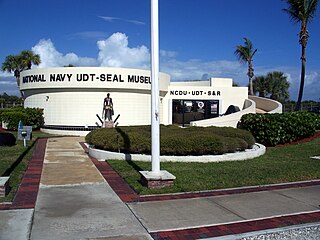
The National Navy UDT-SEAL Museum, also known as the Navy SEAL Museum, is located in St. Lucie County, just outside Fort Pierce, Florida. It houses exhibits to inform and educate on the role of Navy Underwater Demolition Teams (UDT) and Sea, Air, Land (SEAL) teams. The museum also preserves the history of the SEALs.

The US employs divers in several branches of the armed forces, including the navy, army, marines, air force and coast guard.
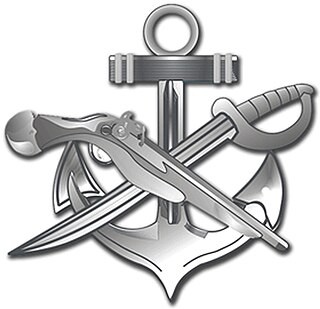
The Special Warfare Combatant-Craft Crewmen is a United States Naval Special Warfare Command team that operates and maintains small craft for special operations missions, particularly those in support of the U.S. Navy SEALs.














